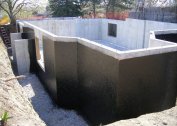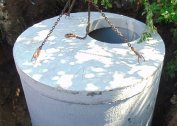Most often, water begins to flow out of the cesspool when it is silted. Insoluble wastes get into drains. As a result, they settle to the bottom of the pit. When a large layer is collected, it turns into a thick crust. It becomes the reason why the outflow of water stops.
Another reason is pollution. This problem mainly concerns housing structures with holes in the walls. Fatty, soapy and hard deposits clog them, water does not leave and the pit overflows.
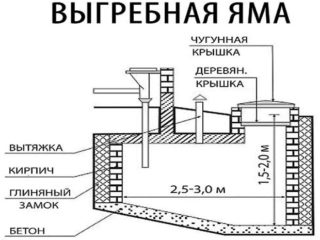 A sharp change in temperature also causes problems. In this case, an ice crust appears on the surface. Then new waste is deposited on the surface. As a result, it seems that the pit is filled to the limit, since the liquid does not come out of it. Another danger is freezing of the bottom. Drains do not go into the ground as it should be.
A sharp change in temperature also causes problems. In this case, an ice crust appears on the surface. Then new waste is deposited on the surface. As a result, it seems that the pit is filled to the limit, since the liquid does not come out of it. Another danger is freezing of the bottom. Drains do not go into the ground as it should be.
There may be other reasons.
- Small volume. Overflow occurs because either the pit volume was not calculated correctly, or the amount of waste increased sharply.
- Groundwater level rise. In this case, after heavy rains or when snow melts in the spring, a large amount of liquid enters the pit. This leads to overflow even if the sewage is minimal or absent.
- Too clay soil. Such soil is not suitable for placement of cesspools: water is absorbed into it very poorly, which leads to overflow.
If a septic tank is used in a cesspool, then its overflow may be caused by insufficient quantity or the collection of chemical waste that destroys microorganisms. The number of bacteria decreases for several reasons:
- the effluent contains a high concentration of alkali, chlorine, acids, which fall into the cesspool of household chemical residues during discharge;
- fresh wastewater does not enter the tank, so microorganisms do not have enough food;
- the tank is poorly insulated, the temperature drops below +4 degrees: in such conditions, bacteria do not survive.
A sign that microorganisms cannot completely clean the tank is dense drains without fractionation.
Methods to Eliminate Bad Outflow
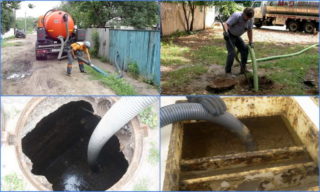 The easiest way is to call the scavengers for help. They will clean the pit with special equipment, wash away the formed layers. It is preliminary recommended that you prepare water barrels on the edge of the pit so that after cleaning it, immediately pour liquid into the tank and pump it out again.
The easiest way is to call the scavengers for help. They will clean the pit with special equipment, wash away the formed layers. It is preliminary recommended that you prepare water barrels on the edge of the pit so that after cleaning it, immediately pour liquid into the tank and pump it out again.
If the water has ceased to be absorbed due to siltation, it is necessary to erode the resulting crust. In this case, proceed as follows:
- pump out fluid from the pit;
- sludge formed at the bottom is washed away by a strong pressure of water;
- then with brushes they clean the bottom of the pit and its walls;
- washed the tank again, pump out the washed-out sludge.
If a large crust has grown, then you can use special preparations based on bacteria that soften the accumulation of sludge. But in this case, there is a limitation: such chemicals are used at temperatures above 0 degrees in high humidity.
The fight against freezing of sewers begins with a qualitative warming of its elements. At the same time, they start from the pipeline. In addition to insulation, you can run an electric cable along the pipe. And in the pit itself, it is necessary to warm up the accumulated drains. For this, hot water is poured into the container and a metal rod is inserted so that it emerges to the surface. The rod is driven through the silt in the corner of the pit into the frozen soil. Next, an electric wire is laid on it and the power is turned on. So in about a day you can warm up a hole with a volume of 2-3 cubic meters.
When only the surface of the liquid freezes, I do the following:
- drill several holes in the ice crust so as to gain access to the liquid;
- ice crust is destroyed by steam;
- effluents are pumped out;
- hot water is poured into the tank.
After all the ice has melted and the temperature of the water in the tank drops below 30 degrees, special biological preparations are poured in order to begin the fermentation of bacteria.
If the pit is too small for the number of drains that fall into it, then it will have to be increased. The easiest way is to form a second tank in the immediate vicinity of the main one. Then both tanks are connected by an overflow pipe. In the new pit, the bottom is made draining, and in the old - concreted. As a result, wastewater is purified, which causes much less damage to the environment than the use of a simple cesspool with natural outflow.
When silting a pit with a sealed bottom, an additional amount of bacteria grown artificially is introduced. In stores, several items are sold that are suitable for cesspools. After the septic tank has been restored, biological preparations are subsequently added to it on a regular basis.
Preventive measures to prevent problems
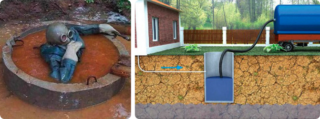 So that problems with emptying the cesspool do not interfere with a comfortable life, preventive measures must be taken.
So that problems with emptying the cesspool do not interfere with a comfortable life, preventive measures must be taken.
- When the cesspool is emptied of the liquid naturally, it is important to ensure that no fat enters it. In particular, it is formed when food waste enters the sewer pit.
- No need to wait until the silt clogs the cesspool and the water stops flowing out of it. It is recommended to wash as described above at least once a year, and preferably once every six months. It is also good to connect chemical or bacterial preparations. Chemicals actively act on fecal sludge and fat and destroy them. Biological products also affect fat and sludge well and decompose them into water and compost. However, they lose their effectiveness if the effluents contain impurities of household chemicals. Therefore, choosing a bacterial preparation, it is better to take a special one that is designed specifically for cesspools.
- Pumping of drains is carried out regularly, without waiting until they begin to flow out. This is especially important for such sewers that are preserved for the winter period.
- When forming the pit, take into account the peculiarities of the local climate, in particular, the depth of freezing of the earth. If the tank approaches this mark, then it is insulated in advance.
- When it was not possible to timely warm the sewer, then around it in cold weather a fire is made to warm the soil. A layer of expanded clay is placed on hot coals. After the fire goes out, conduct insulation with foam. To do this, it is laid around the entire perimeter of the cesspool in two layers. Moreover, the width of the blind area is made equal to the depth of the tank.
Having carried out the indicated preventive measures, it will be possible to avoid problems with overflowing the cesspool.
